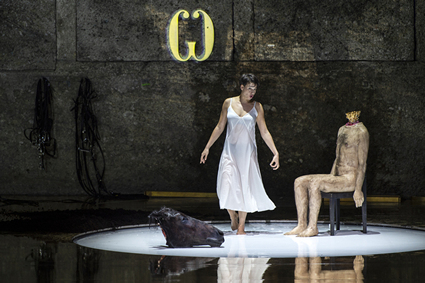| Opera Reviews | 24 April 2024 |
Salzburg's Salome returns in triumphby Moore Parker |
|
| Strauss, R: Salome
Salzburg Festival 28 August 2019 |
|

Asmik Grigorian (Salome)
|
|
|
Following its rousing success last season, Salzburg’s triumph returns - albeit on this occasion with a number of cast-changes among the supporting roles. Romeo Castellucci is responsible for the direction, staging, costumes, and lighting - while Cindy Van Acker undertook the choreography. The stone facade of the Felsenreitschule loses its open niches to become an oppressive backdrop - hinting at a fusion between Jerusalem’s Wailing Wall and an anonymous towering prison courtyard throughout the action. This theme finds its extension in a massive stone block which is lowered following Salome’s dance to envelop and consume the Princess - as the price she pays for her lust. (In fact, for the duration of Strauss’ celebrated dance Salome remains static, in a pose gelled between the foetal and sexual subservience, while poised upon a large gold pedestal marked “SAXA” (Latin, singular “Saxum” for “Stone”) wearing simple black briefs and bound by a strap. The rear wall of the stage displays props hinting at sadomasochism with a leather harness for Jochanaan (to hold him while being showered of his black colour - to reveal skin..”white like the snow on the mountains of Judaea”), and a horse’s saddle to straddle Salome’s back. Castellucci’s equestrian metaphors expand to marry stallions’ reputedly forceful sex-drive with the Biblical reference - where, in Jeremiah 5:8, horse imagery is associated with illicit sexual behaviour. Salome’s self-baptism and cleansing in a pool of milk in an attempt to reinstate her lost innocence (evidently spent as revealed by the blood stain on her white gown) and eliminate her sin, enjoy parity with Jochanaan’s cleansing, as referenced above. Salome’s stain finds its echo in the red-painted lower faces of the other protagonists, except for the Baptist. Jochanaan appears (or rather - fails to appear - since practically invisible) in black face and hirsute cloak, fully shielded by a black circle (moon or sun silhouette, perhaps) - which later expands to envelope the Princess as she succumbs to her lust. The remaining protagonists establish the set period through their costumes, which echo the hypocritically straitlaced Victorians of Oscar Wilde and with affectedly stylised movement and pose, mirrored also in Salome’s gestures - other than during her elemental explosion and sexual release following Jochanaan’s rejection. For the title role, all a demanding exercise - and one superbly met by Asmik Grigorian, whose significant impact in this city actually began earlier - as Marie in Berg’s Wozzeck. Indeed, the entire cast is well-balanced - all within the bounds of the staging and musical concept - and with Grigorian fully convincing as the young princess, physically slender, with silvery tone (pristinely projected), and with an unflinching intensity and veracity to win the day. Correspondingly, her Jochanaan, Gábor Bretz, brings to the part an immaculate line, a winningly-nutty baritone (well-spiced with a hint of previous lower-lying roles), and - as far as visible - a towering stage presence. Most significantly, both artists enunciate extremely well and use their words powerfully - albeit, with the soprano taking occasional liberties in markings and note-values, for effect. John Daszak’s Herodes was well-rounded, text clear, and building effectively with the drama - his hysteria underscored by a rather stiff upper lipped stage spouse, Anna Maria Chiuri. Avery Amereau returned from last season as a finely sculpted Page to compliment Julian Prégardien’s sweet-timbred Narraboth. The remaining cast - while solid - was rather standard in dimension, and somewhat variable in clarity and diction. Franz Welser-Möst captured with his chamber-like attention to detail and dynamic consideration toward the stage forces to hand, while throughout maintaining an ideal rapport between the Wiener Philharmoniker and the protagonists to crown the evening.
|
|
| Text ©
Moore Parker Photo © SF/Ruth Walz |
|







